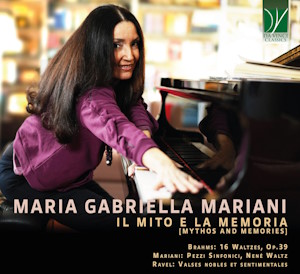
Mythos and Memories
Johannes Brahms (1833-1897)
16 Waltzes Op.39 (1865)
Maria Gabriella Mariani
Pezzi Sinfonici (2022)
Nené Waltz (2021)
Maurice Ravel (1875-1937)
Valses nobles et sentimentales (1911)
Maria Gabriella Mariani (piano)
rec. 2023, unknown location
Da Vinci Classics C00833 [73]
Myth and memory are clearly associated with Ms Mariani’s own works in this attractive recital. The symphonic pieces may be simply named but the three movements each describe one of the nymphs of Greek mythology and her waltz Nené is titled for the ill-fated daughter of her great-grandfather. Memory and dance are both wrapped up in the companion pieces; the Brahms and Ravel waltzes look back to Schubert’s collections of valses and ländler and also to the memory of an opulent age that would soon be lost in the aftermath of turbulence and war in the early twentieth century.
The Brahms are perhaps more familiar in their duet version but the composer simultaneously made two arrangements for solo piano, a straightforward adaption for two hands and a simplified version. Ms Mariani obviously plays the more taxing version and does so very well bringing a vigorous and at times comical nature of the waltzes – they may have been written for a Vienna in love with the waltz but their at times rambunctious swagger seems at odds with the cultured high art of the Austrian capital. My only concern her is in one bar of the tenth waltz where the right and left hand seem to be playing major and minor at the same time. Other than that this is a satisfying set with a richness of texture that is appealing. This richness continues into the Ravel Valses nobles et sentimentales where she also brings a delicacy of touch and flexible rhythms to play. Occasionally I would have preferred a little more dynamic contrast; the vitality at the un peu en dehors in the seventh waltz for instance is admirable but a real pianissimo would have added to the mystery. Nonetheless she effectively captures the languor and fading grandeur of Ravel’s waltzes.
Staying with the waltz theme is Ms Mariani’s own Nené waltz, a slowly unfolding waltz in memory of Antonietta Colantuono, known as Nené, who was the daughter of Ms Mariani’s great-grandfather Domenico and who died after contracting typhoid at the age of twelve. There is a sense of doom in its opening bars with an obstinately repeated note like a tolling bell. All at once this disappears and the waltz becomes more contrapuntal and something of the nostalgia of Sibelius’s valse triste is heard. This is fleeting mood and though there are hints of it later the waltz gradually increases in passion with something of childhood’s swings of mood and interest. The distinctive rhythms that appear here are taken down different paths with each iteration and the writing becomes more turbulent with an intensity that leaves childhood things behind; is Ms Mariani evoking adulthood that Nené never achieved? Even without knowing the background it is wonderful concert waltz that sweeps the listener along into a dizzying kaleidoscopic world.
Mariani’s Pezzi Sinfonici is the most substantial work here, its three movements lasting nearly half an hour. The nymphs of myth and legend are evoked here, Aulionades, nymphs of ravines, cliffs and deep valleys, Dryads, tree nymphs and Oreads, mountain nymphs. The Aulionades were nymphs who associated with the god Pan but there are no fluting arabesques here; Ms Mariani does not endeavour to portray a narrative, rather she conveys the broad vastness of craggy mountainsides in the soaring melodies and richly rolling accompaniment that emerge after the rather ambiguous chordal opening. The spirit of Schumann hovers over the final bars and continues into dryads, the march like opening of the second movement reminiscent of Kreisleriana and the études symphoniques as Ms Mariani points out in her booklet notes. If the lyrical passages that follow have a more contemporary feel elements of Schumann’s’ writing can still be heard as a backdrop. The texture changes to a contrapuntal quasi waltz and the almost cinematic writing that can be heard in the other movements and indeed other works by the composer. The longest movement evokes the Oreads, nymphs of the mountains who were often individually named for the mountain they inhabited. There is a thoughtful starkness to the opening melody and a moodiness and solemnity that, even as it becomes more intense and tempestuous, has a darkly Russian feel. I like the way that Ms Mariani uses texture in the bass of the piano to create an almost orchestral timbre to off set the chordal melody in the right hand, hints perhaps of the piano concerto that was the work’s original destiny. At the half way point a pastorale melody appears, floating over a very simple, sparse accompaniment and Ms Mariani lets this find its own momentum, a crescendo that reaches a climax recalling earlier motifs and, with the addition of a Molise folk melody, ending the movement in grand style.
I have enjoyed the romantic and passionate writing from this composer in earlier releases (Da Vinci Classics C00038 review, C00377 review, review) and the liveliness of performance and inspiration is equalled if not bettered here. Certainly I am drawn to the rolling landscapes of sound that Ms Mariani creates in her symphonic pieces. The couplings are also adept performances though for me it is Ms Mariani’s own compositions that make this such an attractive recital.
Rob Challinor
Availability: Da Vinci Edition

















